বৃহস্পতিবার, ২৯ ডিসেম্বর, ২০১১
শনিবার, ১৭ ডিসেম্বর, ২০১১
Toyota unveils high-tech concept car
Toyota
The automaker's president, Akio Toyoda, called the experimental Fun-Vii "a smartphone on four wheels" at the preview of what Toyota
"A car must appeal to our emotions," Toyoda said, using the Japanese term "waku waku doki doki," referring to a heart aflutter with anticipation.
The Tokyo show has been scaled back in recent years as U.S. and European automakers increasingly look to China U.S.
Toyota's electric vehicle FT-EV III, still a concept or test model, doesn't have a price yet, but is designed for short trips such as grocery shopping and work commutes, running up to 105 kilometres on one full charge. The new small hybrid will be named Aqua in Japan Japan
Toru Hatano, auto analyst for IHS Automotive in Tokyo , believes fuel efficient hybrid models will be popular with Japanese consumers, and Toyota
"The biggest obstacle has to do with costs, and you need to boost vehicle numbers if you hope to bring down costs" he said. "Toyota has more hybrids on the market than do rivals, and that gives Toyota
Zero-emission fuel cell vehicles, which run on hydrogen, have been viewed as impractical because of costs. Toyota
Photo Art On style: 2011 Yamaha FZ8 Review - First Ride2
Photo Art On style: 2011 Yamaha FZ8 Review - First Ride2: Straddling one is also meant to be as unintimidating as possible. Coupled with an identical 32.1-inch seat height, Yamaha says it narrowed ...
শুক্রবার, ১৬ ডিসেম্বর, ২০১১
2011 Yamaha FZ8 Review - First Ride1
Yamaha’s potent yet manageable FZ8 is enough to make its paternal grandfather, the R1, blush with pride. As the latest beneficiary from Yamaha’s repli-racer genetic stock, the 779cc inline-Four is endowed with some of Yamaha’s most inspired sporting technology which should serve it well in its life as an everyday sporting Standard.
The FZ8’s DNA has roots in Yamaha’s premier sportbike, the YZF-R1. The current FZ1’s engine was derived from the pre-crossplane R1. The new offspring inherits the FZ1’s R1-inspired alloy perimeter frame, its chassis geometry, some engine components, as well as many design elements from its compact and efficient engine.
Since we’ve already covered most of the FZ8’s tech details in our preview article, we’ll focus on why Yamaha thinks this bike is a good idea now, and what it’s like to ride.
Why it’s Here
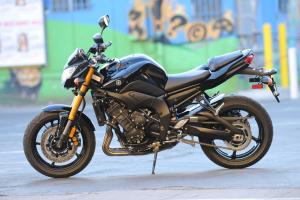
Yamaha says after extensive market research, it decided to import the previously Euro-only FZ8 to the U.S. and Canada for 2011 to span the chasm between 600cc and 1000cc street-oriented sportbikes – while for now bringing its half-faired Fazer 8 sibling only to the Canadians and Euros.
Since 2005, “sportbikes,” including hypersports, sporty bikes, and sport-tourers, have comprised about 20% of all U.S. motorcycle sales, Yamaha says, second only to cruisers, which account for more than 40%.
In mining demographic data in these recessionary times, Yamaha sees a glint of gold in a trend toward buyers who want one do-it-all sportbike. Some of these buyers will be replacing existing bikes, or trading up from smaller bikes, while at the same time there’s a 9% decline in those seeking an additional bike to add to a stable.
Among 53 buyer preferences Yamaha researched, high on the list were rider positioning, attainable price, large-enough displacement, color and graphics, physical size, ease of touching feet to the ground, light and maneuverable handling, fuel economy, and more.
In short, the mission was to create a versatile and economical bike that comes closer than ever to letting riders with sporting inclinations have their cake and eat it too.
After sampling an FZ8 for nearly 130 miles, in conditions varying from highways to canyons to around town, we would say that this new machine could certainly fit the bill.
How it Works
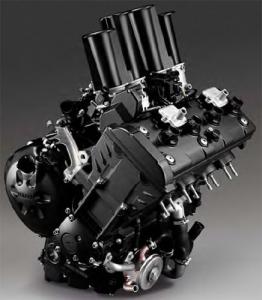
Depending on whether you’re feeling like a glass-half-full or half-empty kind of person, you could either say the FZ8 feels like a 600 – but with power like a strong 750 – or you could say it’s like a detuned, lighter FZ1.
But while the FZ8’s 12.0:1 compression, fuel-injected engine shares the FZ1’s crankcase, 53.6mm stroke and basic architecture, it is not accurate to call it a sleeved-down version of the 11.5:1 compression FZ1 mill.
To begin with, the FZ8’s four-valve-per cylinder head is all new, as are its shorter lift and duration camshafts, and new intake funnels – 125mm-long for cylinders 1 and 4, and 150mm-long for cylinders 2 and 3 – that help broaden its powerband.
Coupled with its 35mm throttle body – 10mm narrower than the FZ1’s – these features enhance torque while still allowing for a respectable top-end rush.
Yamaha doesn’t make power claims, but the FZ8’s 11,500-max-rpm mill reportedly peaks at around 105 hp, and 61 ft-lb torque when measured at the crankshaft.
Speaking of which, the crankshaft is modeled on the FZ1’s but weighs 30% less, which Yamaha says helps it still rev quickly, while positively influencing handling.
How? Although the FZ8’s 467-lb curb weight is only 20 lbs lighter than its big brother, Yamaha says decreased crankshaft inertial mass can be discerned in the way the bike transitions from side to side. Coupled with a 10mm-narrower rear tire, Yamaha says the FZ8 feels 50 lbs lighter. We didn’t have an FZ1 to compare it to, but it’s at least sure the FZ8 exhibits a nimbleness that belies its mass.
The FZ8’s DNA has roots in Yamaha’s premier sportbike, the YZF-R1. The current FZ1’s engine was derived from the pre-crossplane R1. The new offspring inherits the FZ1’s R1-inspired alloy perimeter frame, its chassis geometry, some engine components, as well as many design elements from its compact and efficient engine.
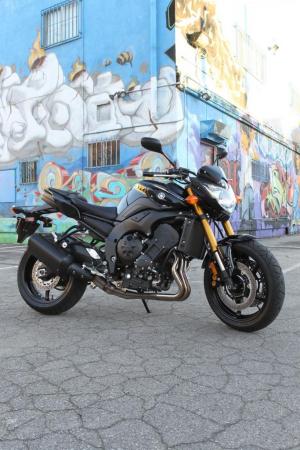 |
Why it’s Here

Yamaha says after extensive market research, it decided to import the previously Euro-only FZ8 to the U.S. and Canada for 2011 to span the chasm between 600cc and 1000cc street-oriented sportbikes – while for now bringing its half-faired Fazer 8 sibling only to the Canadians and Euros.
Since 2005, “sportbikes,” including hypersports, sporty bikes, and sport-tourers, have comprised about 20% of all U.S. motorcycle sales, Yamaha says, second only to cruisers, which account for more than 40%.
In mining demographic data in these recessionary times, Yamaha sees a glint of gold in a trend toward buyers who want one do-it-all sportbike. Some of these buyers will be replacing existing bikes, or trading up from smaller bikes, while at the same time there’s a 9% decline in those seeking an additional bike to add to a stable.
Among 53 buyer preferences Yamaha researched, high on the list were rider positioning, attainable price, large-enough displacement, color and graphics, physical size, ease of touching feet to the ground, light and maneuverable handling, fuel economy, and more.
In short, the mission was to create a versatile and economical bike that comes closer than ever to letting riders with sporting inclinations have their cake and eat it too.
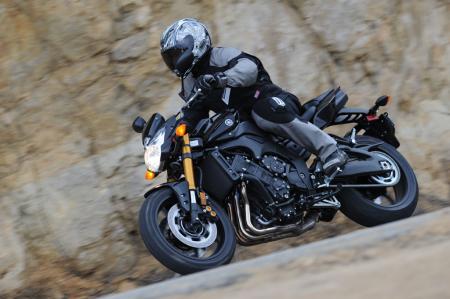 |
How it Works

Depending on whether you’re feeling like a glass-half-full or half-empty kind of person, you could either say the FZ8 feels like a 600 – but with power like a strong 750 – or you could say it’s like a detuned, lighter FZ1.
But while the FZ8’s 12.0:1 compression, fuel-injected engine shares the FZ1’s crankcase, 53.6mm stroke and basic architecture, it is not accurate to call it a sleeved-down version of the 11.5:1 compression FZ1 mill.
To begin with, the FZ8’s four-valve-per cylinder head is all new, as are its shorter lift and duration camshafts, and new intake funnels – 125mm-long for cylinders 1 and 4, and 150mm-long for cylinders 2 and 3 – that help broaden its powerband.
Coupled with its 35mm throttle body – 10mm narrower than the FZ1’s – these features enhance torque while still allowing for a respectable top-end rush.
Yamaha doesn’t make power claims, but the FZ8’s 11,500-max-rpm mill reportedly peaks at around 105 hp, and 61 ft-lb torque when measured at the crankshaft.
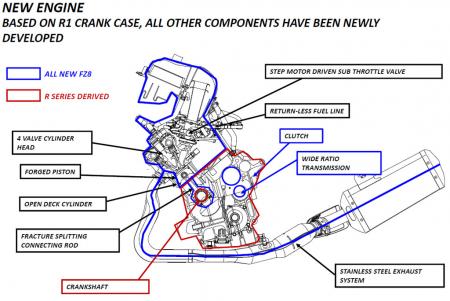 |
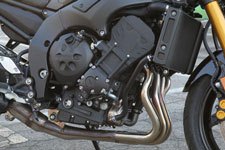 | 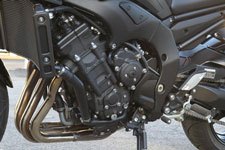 |
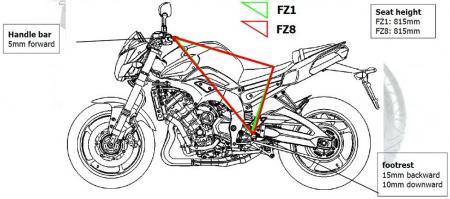 |
2011 Yamaha FZ8 Review - First Ride2
Straddling one is also meant to be as unintimidating as possible. Coupled with an identical 32.1-inch seat height, Yamaha says it narrowed the rear of the 4.5 gallon fuel tank and the front of the rider’s saddle just to help shorter riders reach the ground.
The FZ8’s riding position is slightly more aggressive than the FZ1’s, yet still relatively neutral and functional. Handlebars are 5mm forward, while the footpegs are 15mm more rear set and 10mm lower.
And while Yamaha took pains to meet those of lesser stature, surprisingly enough, a 6-foot, 5-inch motojourno who was along for our ride reported he had no discomfort either.
Also displaying no unwanted issues is its operability. Start-up is instant, whereupon it settles into a steady idle around 1100 rpm indicated on the analog tachometer, which resides next to the digital display for speed, fuel, temperature, and trip data. (At night, backlighting is red.)
Twisting the throttle yields immediate response; the engine revs smoothly and its power characteristics would make it reluctant to stall even under a newbie's wrist. Ample torque fed through a clutch – with one less fiber and metal plate than the FZ1 – coupled with a light clutch-lever engagement make it a snap to get rolling.
The FZ8’s 17-inch Bridgestone Battlax BT021 sport-touring tires – 120/70 in front, and 180/55 out back – were developed specifically for it, and contribute to predictable characteristics.
They span between a 57.5-inch wheelbase sporting a 51/49, front/rear weight bias. The package is held up by a non-adjustable 43mm KYB fork, and preload-adjustable shock, each offering 130mm of travel.
Whether trolling down the highway, or bending through canyon S-curves in mile after undulating mile, the setup works.
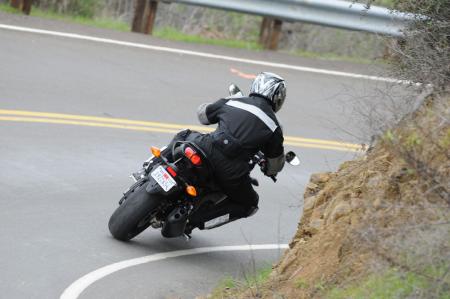 Thanks to Aerostich for its GORE-TEX® Roadcrafter one-piece suit – the perfect outfit for a cool and slightly rainy day. Thanks to Aerostich for its GORE-TEX® Roadcrafter one-piece suit – the perfect outfit for a cool and slightly rainy day. |
And really, as-delivered it’s not much of a problem. While the springs aren’t especially firm, handling only became somewhat less confidence inspiring under my 185 lbs plus gear when pitched over, charging hard traversing rough or patch-repaired pavement.
This ability to take what comes is mostly due to the FZ1 chassis. The over-built alloy perimeter frame, and huge, shapely alloy swingarm hold everything in line as the horizon tilts to peg-scraping angles, inspiring riders to keep dipping deeper and faster.
The chassis is welcome considering the FZ8 engine is a mean little runner and makes for an effective tool that you don’t have to spool up like an Indy car to make haste, the way you do with a 600cc supersport.
While I admit a bit of unease about riding hard on OE sport-touring tires in cool weather – and if it were mine, I’d slap on some sticky sport tires just for the extra performance margin – the Bridgestones never slipped during spirited riding, even after running over medium-quality asphalt curves that had just been sprinkled by light rain.
And no matter what the corner or speed, gearing for the 6-speed transmission is well-matched to engine output. The FZ8’s gearbox differs only from the FZ1’s by a lower final-drive ratio and lower first gear – which nevertheless hits an indicated 74 mph when bouncing off the rev limiter.
Sprints to 100 mph and beyond are no big deal, though we did not try to see how high we could climb. Likewise, reversing thrust with the 310mm discs grasped by monoblock four-pot calipers up front, and 267mm rear disc is easy and predictable, regardless of the bike’s velocity.
The 4-into-2-into-1, catalyst-equipped, stainless-steel exhaust, with shorty muffler tastefully blacked out, emits a suitably powerful but muted note. This is especially true in the upper range, where – milder cams or not – the familiar snarl of a tight inline-Four coming on the pipe matches the resultant switch to warp drive.
Lacking the FZ1’s taller half fairing, the FZ8’s protection from the elements is limited, but wind-blocking gear negated the need for more coverage, at least this time. Yamaha does offer a $129.95 smoked polycarbonate fly screen (not tested), which could help if desired.
2011 Yamaha FZ8 Review - First Ride
Conclusion
If the race toward repli-racer superiority has done anything for the rest of motorcycling, it’s been to create a rich repository of technology ready to be re-tasked in bikes like Yamaha’s latest rendition of the Universal Japanese Motorcycle.
And as of yet, the $8490 FZ8 is essentially in a class by itself. It offers 80% the low and midrange torque that a literbike does – instead of something like 55-60% typical to a peaky 600 supersport. At the same time, it is about as agile as a 600, but its several-thousand-rpm lower operating range will be easier going on all those close-tolerance internal parts.
Of course, with limited suspension adjustability, and being somewhat heavier than uber-competitive 600 supersports, it is not really a direct opponent, but merely a competitive alternative for riders looking for a broadly talented performer.
In terms of displacement, the FZ8 best lines up with the 798cc parallel-Twin BMW F800R we recently tested. While we did not compare them back to back, the FZ8 feels more potent than the $9950 BMW. In terms of power, Triumph’s 675cc Street Triple is likely a close match, as is its $8899 MSRP
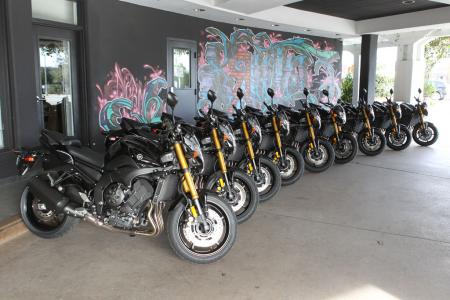 Yamaha had a fleet waiting for us at the lobby of a hotel in Venice, Calif. Yamaha had a fleet waiting for us at the lobby of a hotel in Venice, Calif. |
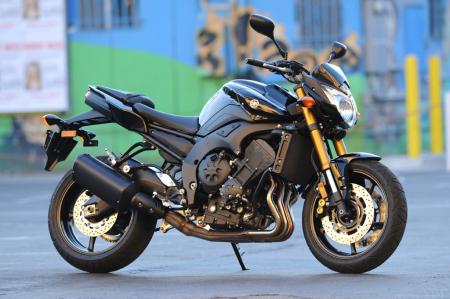 While there are bikes that arguably compete, in a real sense, the FZ8 stands alone. While there are bikes that arguably compete, in a real sense, the FZ8 stands alone. |
Unfortunately, that most useful of options – ABS – as offered in Europe, is not available in the U.S.
Offered in Raven (black) for this year only, Yamaha says it is shipping the FZ8 now, and has met with enthusiastic response from U.S. dealers who have pre-ordered an undisclosed quantity that nevertheless has Yamaha reps satisfied. They tell us the supposition is that this is a bike that should sell.
After sampling the versatile mid-heavyweight, we can definitely see why this could be so.
Interested in finding out more about the FZ8? Join our free Yamaha FZ8 Forum.
Here are three ways to satisfy a thirst for a powerful sportbike without the pretzel-ed legs and sore wrists.
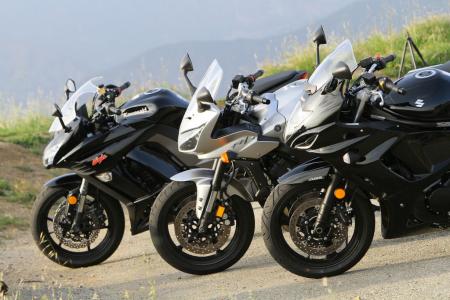 Liter-sized sportbikes without torture-rack ergos can ably shift from commuter to sport-tourer to canyon-carver.
Liter-sized sportbikes without torture-rack ergos can ably shift from commuter to sport-tourer to canyon-carver.The Ninja counters with a greater sport focus and a raging four-cylinder engine from the Z1000 but doesn't necessarily assure conquest of the other two. In fact, each of our 40-plus-year-old group of testers presents convincing reasons why either bike could win this shootout, depending on the potential rider. The rebadged Bandit (aka, GSX) and long-in-the-tooth (well, since 2006…) Yamaha FZ1 retain some superior qualities Ninja engineers dismissed, forgot or didn’t realize they should incorporate on their new liter-sized sportbike.
What the Ninja has on its Yamaha competitor is motor — gobs and gobs of mid-range motor. An impromptu six-gear roll-on with Editor Duke on the Kawasaki left me on the Yamaha counting seconds while the FZ1’s inline four-cylinder spun up revs. Once in the meat of the R1-derived engine’s powerband the forward surge was invigorating, but by this time Duke was an off-ramp down the freeway. By itself the FZ1 is plenty fast, but when up against the new Ninja the Yamaha feels downright anemic until spun up.
“A motorcycle’s engine is a key ingredient in riding dynamics, and in this respect, the Ninja’s motor delivers a superior experience,” says Editor Duke. “Its low-end hit easily outmuscles the Yamaha, and its shorter gearing always has the engine in its expansive sweet spot. Any race across an intersection will be won by the Kawi.”
The GSX1250FA, with its 72.3 ft-lb of torque at 3,500 rpm, is a better match for the Ninja’s 71.6 ft-lb at 7,800 rpm. But with a curb weight of 567 lbs., the portly Suzuki is 64 lbs. heavier than the Kawasaki (503 lbs.) and 80 lbs. more than the FZ1 (487 lbs.). With 68 ft-lb or more of torque from an rpm as low as 2,700 rpm to a high of 6,800 rpm the GSX has, in fact, the broadest spread of torque of the three bikes by a big margin. Where the GSX falls short is in the horsepower department, producing a paltry 92.6 hp at 8,800 rpm compared to the Ninja’s 121.1 at 10,100 rpm and the FZ’s 125.1 horses all the way up at 11,300 rpm.
To say that Kawasaki got it right with this engine is an understatement. The new Ninja 1000 has the perfect blend of sportbike performance packaged to be delivered in usable quantities during street riding conditions. According to “Resident Boomer,” Glenn Giardinelli, “The Ninja 1000 pushes the envelope of what a gentleman's sportbike can be. Kawasaki made a potent motor for everyday street use. This bike has more low- and mid-range torque than any stock sportbike I've ridden.”
Considering the Suzuki’s displacement of 1255cc (79.0 mm x 64.0 mm bore and stroke), not producing a triple-digit horsepower figure is somewhat disappointing but is generally masked by its phenomenal torque output – it cranks out low-rev power like a V-Twin.
With seating position, reach to handlebars and the distance from seat to footpeg hardly discernible between them, all three bikes earn gold stars for comfort. But in terms of long-haul comfort, the Suzuki is the new class standard.
“The Suzuki 1250FA is a great sport-tourer,” notes Boomer Giardinelli. “It is easily the most comfortable bike in the test and I would say one of the best anywhere, outside full-on, two-wheel land yachts. Part of the reason the bike is so comfortable is its ability to smooth out the bumps and potholes on the road.”
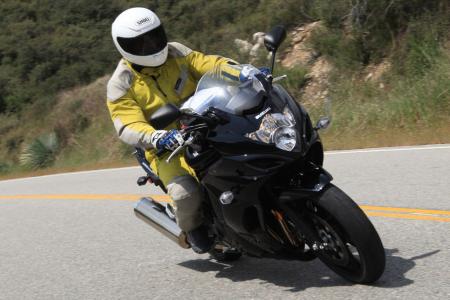 “The Suzuki 1250 really reminds me of a lighter, sportier, 7/8-scale FJR1300,” says the day-glo Kevin Smith. “Which is no bad thing.” “The Suzuki 1250 really reminds me of a lighter, sportier, 7/8-scale FJR1300,” says the day-glo Kevin Smith. “Which is no bad thing.” |
 |
| http://www.motorcycle.com/manufacturer/yamaha/2012-yamaha-and-star-motorcycles-model-preview-91128.htmlhttp://www.motorcycle.com/manufacturer/yamaha/2012-yamaha-and-star-motorcycles-model-preview-91128.html |
So far the SCL only consists of the Raider SCL, but expect SCL versions of other popular Star models down the pipeline. At $19,990, the Raider SCL is an attractive offer for a factory custom, and hopefully we’ll get to ride it, along with the rest of the 2012 Star line, come February during Star’s official press event.
লেবেলসমূহ:
MOTORBYK,
MOTORCYKAL WALLPAPER
2012 Yamaha YZF-R1 Review
বৃহস্পতিবার, ১৫ ডিসেম্বর, ২০১১
এতে সদস্যতা:
পোস্টগুলি (Atom)

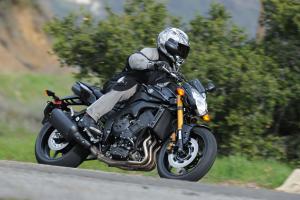 Comfortable, confidence-inspiring, and sufficiently powerful.
Comfortable, confidence-inspiring, and sufficiently powerful.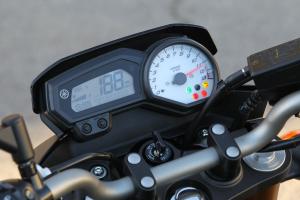
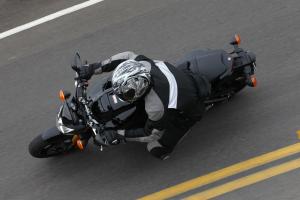 It’s easy to get used to this bike.
It’s easy to get used to this bike.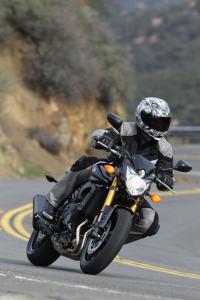 The extra torque over a 600-class bike is welcome.
The extra torque over a 600-class bike is welcome.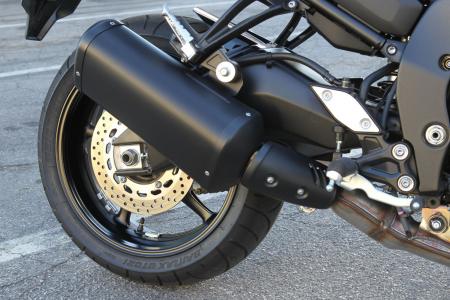 Of course it might sound cooler with an aftermarket exhaust, and make a few extra ponies. The stock system gives the stealth factor, however. You can scream it when you need to, without drawing unwanted attention. Note curvaceous, control-filled die-cast aluminum swingarm. The process lets Yamaha precisely tune its characteristics.
Of course it might sound cooler with an aftermarket exhaust, and make a few extra ponies. The stock system gives the stealth factor, however. You can scream it when you need to, without drawing unwanted attention. Note curvaceous, control-filled die-cast aluminum swingarm. The process lets Yamaha precisely tune its characteristics. 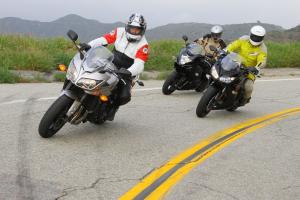 Gentlemen sportbikes strike a balance between race-replica performance and sport-touring comfort.
Gentlemen sportbikes strike a balance between race-replica performance and sport-touring comfort.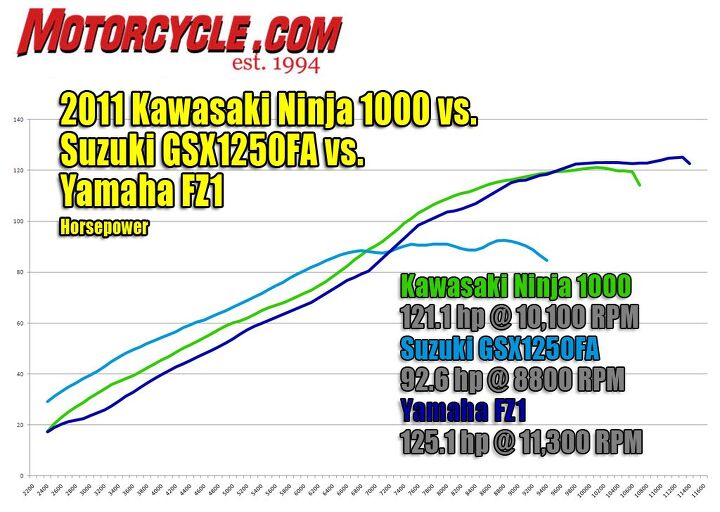 The Suzuki's big-cube engine can't be touched down low, but it's choked up after 6500 rpm when the smaller engines start wailing. The FZ1 produces the most peak power, but its advantage only makes itself known in quintuple-rpm digits. Everywhere else, the Ninja feels quite a bit stronger. (A torque chart can be found in our photo gallery.)
The Suzuki's big-cube engine can't be touched down low, but it's choked up after 6500 rpm when the smaller engines start wailing. The FZ1 produces the most peak power, but its advantage only makes itself known in quintuple-rpm digits. Everywhere else, the Ninja feels quite a bit stronger. (A torque chart can be found in our photo gallery.)



